Sugar Daddy and I have just returned from a cool after-dinner walk in Grandpa Cape Town’s neighbourhood, and Swee’pea is sleeping peacefully in the stroller. As we set out, the colours over the mountain were spectacular: a brilliant orange fading somehow into purple. By the time we got into a better position to see it, the sky and clouds over the mountain had mostly faded to the same bleached out silver we’ve seen the last couple of nights we’ve gone for a walk to try to get Swee’pea to sleep. Last night, the other side of the sky was bright blue, providing a stunning contrast to the nearly full moon. I can’t believe it’s so full, when it seems like just yesterday it was a tiny sliver of a crescent over the mountain.

While we walked we tried to articulate our thoughts about today’s outing. Today we went on a township tour. It wasn’t quite such an amazing, serendipitous experience as our 2005 tour of Soweto, but it was good, and in some ways more encouraging than the Soweto tour. Today, our guide, Gladstone, began the tour at the District Six Museum, at our request. We didn’t have enough time there to really take in much, but it was a good stop to begin the tour, and many of the exhibits were donated by former residents. The guide book says that most of the staff of the museum are also former residents. As I understand it, District Six used to be a vibrant, multicultural, fairly poor area downtown Cape Town. The first forced removal was in 1901, before formal apartheid, when blacks were removed from the area. Then after apartheid was formalized, it was declared a whites only neighbourhood, and all the coloured people were removed to other townships. (Apparently, police would invoke ‘the pencil test’ to determine whether someone was coloured or black: if a pencil got stuck in their hair, the person was black; if not, they were coloured. As a result, black people started shaving their heads and straightening their hair to pass the test.) Essentially, the area was bulldozed, completely destroyed; except, of course, for the buildings that were white-owned. Those remained untouched. But the area mostly stands empty today, because white people didn’t feel right about the situation, and mostly wouldn’t buy the land. (I wasn’t always listening to Gladstone very carefully, so I may have some of the details wrong.) Apparently, the government is trying to provide some form of restitution, building new houses for the former residents, and 24 families have moved into the new dwellings.
The museum has some great photography, and in most cases the photographer and the donor were listed underneath each photograph. I found myself wondering about the photographers, and what their motives were in make the images. Were they like me, and sort of amateur photographers? Were they professional photographers? Or did they have a notion to try to preserve some of the vitality of the buildings and streets? Sometimes the photographers were also the donors, other times the donor was different but shared the same last name. Rarely (if ever – I can’t remember now) were the photographer and donor completely different.
After a walk around the small museum, which is housed in the “Freedom Church” – so called because most of the people gethered to discuss political matters rather than to worship – we got back into the van and went to Langa Township, the oldest township in the Cape. There was one other older township, where the blacks from District Six were removed to in 1901, but it was demolished to become industrial land. I think Langa came into being sometime around 1929 or 1936 or something like. Many of the houses we drove by were cute little two-room dwellings with doors open and/or people sitting out front. They were mostly painted cheerful colours, and generally well-maintained. Apparently, their inhabitants used to have to pay rent, but after apartheid was abolished, the government just gave them to the residents.
We went to an arts and crafts centre, called Gugu Sthebe or something like that. The outside of the place was decorated with beautiful mosaic murals, with tables and seats, also decorated with mosaics.
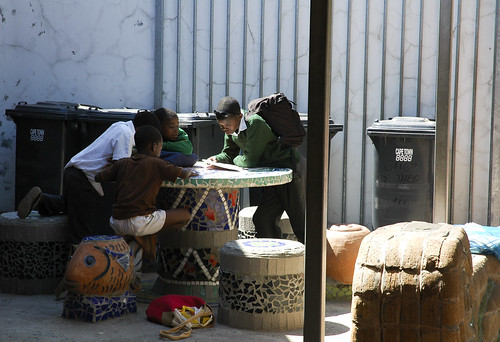
After a tour, we sat outside for a few minutes, waiting, and there was a young boy just sitting.

He had kind of a sad expression on his face, likely cultivated for our benefit, but he didn’t talk and wouldn’t respond to questions from a young, black, British social worker whose mother was born in South Africa. She was an interesting woman to have on the tour, vibrant and outgoing, but also clearly having a more emotional response then I was. I don’t think she’d ever seen a township closeup before. Anyways, as we were leaving the boy gestured to her for a drink, with irresistable, pleading eyes. She was drinking a can of coke, and she said, “Oh help. Can I give him the coke?” and then handed it over (the guide had discouraged us from giving sweets and things to the kids, but he was so polite and adorable, I totally would have handed it over too).

Then we went to the hostels, which are in the process of being renovated into single family units. First, we went to an unrenovated hostel, the same as they were for the men forced into close quarters when they came to the city for work and left their families behind in the homelands of apartheid. We entered a common area, with loud lively kwaito music coming from somewhere. The walls and ceiling were very dark, and I wondered why, after so many cheerful colours outside. Gladstone told me it was because of the smoke from the parafin stove they have to cook with. A baby boy was sitting on the concrete floor, and there were no adults around, other than Gladstone and us tourists. I couldn’t stop looking at him. He was big and I figured he must be older than Swee’pea to be able to sit alone in a room. Gladstone was talking about the living conditions, but I wasn’t really listening, so absorbed was I with this little boy, sitting on the floor below a pile of large drums made with animal skins.
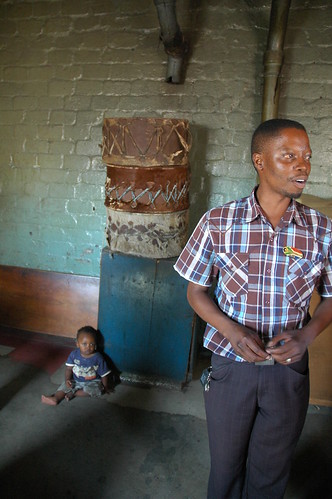
Finally, a woman came and picked him and took him out of the room, and I could pay attention to the lesson. After the discussion, we were invited to explore on our own, and talk to the residents.
There are six rooms in the hostel, with a tiny ill-equipped kitchen, and I think a bathroom, though I didn’t see it. Each room has three single beds, essentially a bed per family. In these 18 beds, 54 people sleep. My mind continues to boggle at this number. But people seemed mostly pretty cheerful. Gladstone made friends with Swee’pea, and picked him up and took him into a room where his sister-in-law was with her twin baby boys. They were with a middle-aged woman, who was a healer of some kind.

Once there, Swee’pea started to cry, so I took him back, but I was surprised he let Gladstone hold him at all. He hasn’t really let any family members other than Sugar Daddy and I hold him since we’ve been here. I chatted with the twins’ mother, about the craziness or early motherhood and what it’s like squared. We went into another room, where the first little boy was being held by a woman. She said he wasn’t hers, his mother was…. (pause) elsewhere (vague gesture). Apparently, he’s only 8 months old, and at least as big as Swee’pea is now, and Swee’pea’s big, so obviously, he’s doing pretty well.
Then I went into another room, on the other side of the common room, and I noticed a very pretty young woman, wearing very well-pressed clothes ironing on her bed. I asked to take a picture, but you can’t see the iron in it the way I would have liked. It kind of made me laugh, at myself, that a woman in these conditions dresses so well and owns an iron, when I don’t even own one, and if I did, I seriously wouldn’t know how to use it.
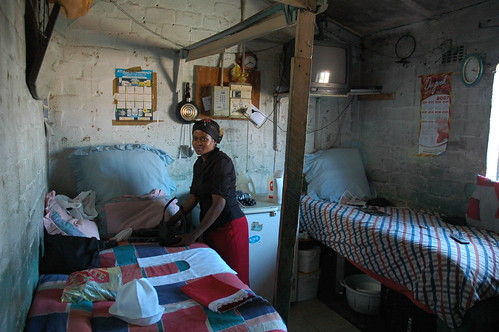
We sat down in the common area for a bit, and I nursed Swee’pea. Another young woman said something, and then explained it was her mother tongue’s word for breastfeeding. It’s a very onomatopeic word, which I won’t even try to spell out here, but she began to talk about how much better breastfeeding is. She said she has a baby boy, up in the Northwest Province with her mother (I think that’s where Pilanesberg is – all the way up past Joburg). I asked if she was working (something like 60 percent of the township’s residents are unemployed) and she said no. I said it must be hard, being away from her son, but she just shrugged after thinking for a minute, and said, “Yeah, but jobs are so hard to come by…”
After a bit, we left and went to an apartment in a renovated hostel. It had a tiny kitchen, which doubled as a living room with a tv, a bedroom and a bathroom. People pay R200 a month for these flats, and after five years of paying rent, they own it. Then we hung out by the tour van, next to a craft vendor, and a store with fruits and veg outside. As we approached the van, a young girl came up to me, gestured at my camera, and started striking poses. She is serious model material. I clicked away, then she insisted on seeing the pictures on the back of the camera (thank goodness I went digital), and then she turned to another tourist for more fashion diva poses.

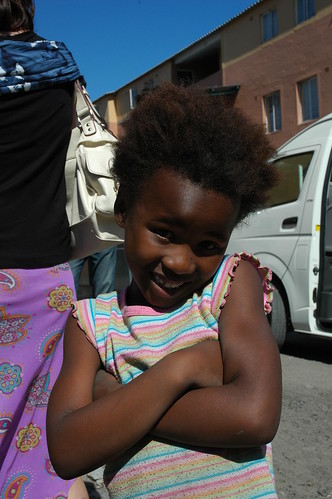
There were quite a few people, just sitting by the road, or on steps, or standing and chatting. It occurred to me that you would never see people outside their houses like this in my neighbourhood, and certainly not in Grandpa Cape Town’s with all the walls. The children looked well and happy, and it didn’t look like anyone was going hungry. Obviously, there is a great sense of community, and with so many unemployed, people must share a lot. I have to say that I really didn’t feel any pity for these people. They have a lot less than I do, but once again I am struck by the signs of a good quality of life, in spite of having way less material wealth. I don’t want to minimize people’s suffering, or the lingering effects of apartheid, or the painfully slow pace of reformation, but still…
After that, we drove through an informal settlement of homemade shacks, with communal toilets and taps. We didn’t get out of the van again until we got back to Grandpa Cape Town’s house, the silent empty road between the tall walls a striking contrast to the boisterous community we’d just left.
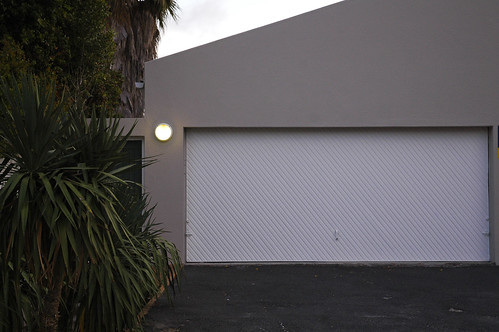
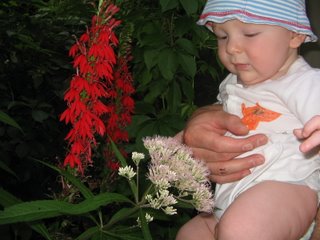







6 comments:
SOunds amazing, really amazing. Will you post pics?
Another lovely travel story--your tales are all so thoughtful, that when I imagine you there, I see you with a kind of furrowed brow, taking it all in. In a good way!
sister.
wow. just wow. i love your post.
LOVELY post. GORGEOUS photos. I loved it.
I'm trying to figure out why I never commented on this and then I noticed the date stamp. I'm pretty sure I read it while working the reference desk and didn't get a chance to comment.
It is truly lovely, Sin and it was so nice to re-read it with all the photos embedded.
K and I spent a long time at that District Six museum in 2002. It's such an amazing and amazingly sad story.
Also, we were struck by the sharp similarities and very sharp differences too between the civil rights movement in the U.S. and our own history of racism and the way things played out there...
Too many thoughts for a comment box.
Why am I just seeing this now? Arg.
Post a Comment